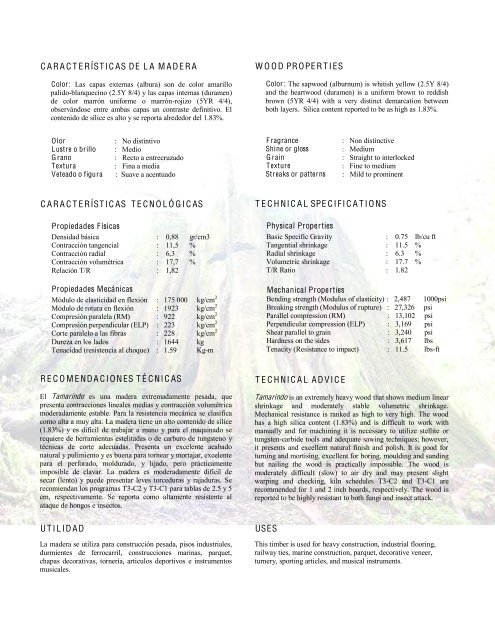Catálogo Maderas de Panamá - WWF
Catálogo Maderas de Panamá - WWF
Catálogo Maderas de Panamá - WWF
Create successful ePaper yourself
Turn your PDF publications into a flip-book with our unique Google optimized e-Paper software.
C A R A C T E RÍSTI C AS DE L A M A D E R A<br />
Color: Las capas externas (albura) son <strong>de</strong> color amarillo<br />
palido-blanquecino (2.5Y 8/4) y las capas internas (duramen)<br />
<strong>de</strong> color marrón uniforme o marrón-rojizo (5YR 4/4),<br />
observándose entre ambas capas un contraste <strong>de</strong>finitivo. El<br />
contenido <strong>de</strong> sílice es alto y se reporta alre<strong>de</strong>dor <strong>de</strong>l 1.83%.<br />
Olor : No distintivo<br />
Lustre o brillo : Medio<br />
G rano : Recto a entrecruzado<br />
Textura : Fina a media<br />
Veteado o figura : Suave a acentuado<br />
C A R A C T E RÍSTI C AS T E C N O L Ó G I C AS<br />
Propieda<strong>de</strong>s Físicas<br />
Densidad básica : 0,88 gr/cm3<br />
Contracción tangencial : 11,5 %<br />
Contracción radial : 6,3 %<br />
Contracción volumétrica : 17,7 %<br />
Relación T/R : 1,82<br />
Propieda<strong>de</strong>s Mecánicas<br />
Módulo <strong>de</strong> elasticidad en flexión : 175 000 kg/cm 2<br />
Módulo <strong>de</strong> rotura en flexión : 1923 kg/cm 2<br />
Compresión paralela (RM) : 922 kg/cm 2<br />
Compresión perpendicular (ELP) : 223 kg/cm 2<br />
Corte paralelo a las fibras : 228 kg/cm 2<br />
Dureza en los lados : 1644 kg<br />
Tenacidad (resistencia al choque) : 1.59 Kg-m<br />
R E C O M E ND A C I O N ES T É C NI C AS<br />
El Tamarindo es una ma<strong>de</strong>ra extremadamente pesada, que<br />
presenta contracciones lineales medias y contracción volumétrica<br />
mo<strong>de</strong>radamente estable. Para la resistencia mecánica se clasifica<br />
como alta a muy alta. La ma<strong>de</strong>ra tiene un alto contenido <strong>de</strong> sílice<br />
(1.83%) y es difícil <strong>de</strong> trabajar a mano y para el maquinado se<br />
requiere <strong>de</strong> herramientas estelitadas o <strong>de</strong> carburo <strong>de</strong> tungsteno y<br />
técnicas <strong>de</strong> corte a<strong>de</strong>cuadas. Presenta un excelente acabado<br />
natural y pulimiento y es buena para tornear y mortajar, excelente<br />
para el perforado, moldurado, y lijado, pero prácticamente<br />
imposible <strong>de</strong> clavar. La ma<strong>de</strong>ra es mo<strong>de</strong>radamente difícil <strong>de</strong><br />
secar (lento) y pue<strong>de</strong> presentar leves torceduras y rajaduras. Se<br />
recomiendan los programas T3-C2 y T3-C1 para tablas <strong>de</strong> 2.5 y 5<br />
cm, respectivamente. Se reporta como altamente resistente al<br />
ataque <strong>de</strong> hongos e insectos.<br />
U T I L ID A D<br />
La ma<strong>de</strong>ra se utiliza para construcción pesada, pisos industriales,<br />
durmientes <strong>de</strong> ferrocarril, construcciones marinas, parquet,<br />
chapas <strong>de</strong>corativas, tornería, articulos <strong>de</strong>portivos e instrumentos<br />
musicales.<br />
W O O D PR OPE R T I ES<br />
Color: The sapwood (alburnum) is whitish yellow (2.5Y 8/4)<br />
and the heartwood (duramen) is a uniform brown to reddish<br />
brown (5YR 4/4) with a very distinct <strong>de</strong>marcation between<br />
both layers. Silica content reported to be as high as 1.83%.<br />
F ragrance : Non distinctive<br />
Shine or gloss : Medium<br />
G rain : Straight to interlocked<br />
Texture : Fine to medium<br />
Streaks or patterns : Mild to prominent<br />
T E C H NI C A L SPE C I FI C A T I O NS<br />
Physical Properties<br />
Basic Specific Gravity : 0.75 lb/cu ft<br />
Tangential shrinkage : 11.5 %<br />
Radial shrinkage : 6.3 %<br />
Volumetric shrinkage : 17.7 %<br />
T/R Ratio : 1.82<br />
Mechanical Properties<br />
Bending strength (Modulus of elasticity) : 2,487 1000psi<br />
Breaking strength (Modulus of rupture) : 27,326 psi<br />
Parallel compression (RM) : 13,102 psi<br />
Perpendicular compression (ELP) : 3,169 psi<br />
Shear parallel to grain : 3,240 psi<br />
Hardness on the si<strong>de</strong>s : 3,617 lbs<br />
Tenacity (Resistance to impact) : 11.5 lbs-ft<br />
T E C H NI C A L A D V I C E<br />
Tamarindo is an extremely heavy wood that shows medium linear<br />
shrinkage and mo<strong>de</strong>rately stable volumetric shrinkage.<br />
Mechanical resistance is ranked as high to very high. The wood<br />
has a high silica content (1.83%) and is difficult to work with<br />
manually and for machining it is necessary to utilize stellite or<br />
tungsten-carbi<strong>de</strong> tools and a<strong>de</strong>quate sawing techniques; however,<br />
it presents and excellent natural finish and polish. It is good for<br />
turning and mortising, excellent for boring, moulding and sanding<br />
but nailing the wood is practically impossible. The wood is<br />
mo<strong>de</strong>rately difficult (slow) to air dry and may present slight<br />
warping and checking, kiln schedules T3-C2 and T3-C1 are<br />
recommen<strong>de</strong>d for 1 and 2 inch boards, respectively. The wood is<br />
reported to be highly resistant to both fungi and insect attack.<br />
USES<br />
This timber is used for heavy construction, industrial flooring,<br />
railway ties, marine construction, parquet, <strong>de</strong>corative veneer,<br />
turnery, sporting articles, and musical instruments.

















